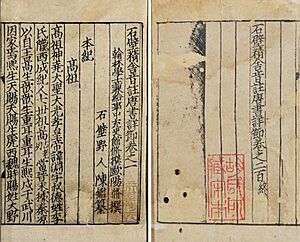New Book of Tang facts for kids
Quick facts for kids New Book of Tang |
|||||||||||||
|---|---|---|---|---|---|---|---|---|---|---|---|---|---|
| Traditional Chinese | 新唐書 | ||||||||||||
| Simplified Chinese | 新唐书 | ||||||||||||
|
|||||||||||||
The New Book of Tang is a very important official history book. It tells the story of the Tang dynasty, a powerful period in Chinese history. This huge work has ten volumes and 225 chapters.
A team of scholars from the Song dynasty wrote it. The main leaders of this team were Ouyang Xiu and Song Qi. For a long time, until the 1700s, people just called it the Tangshu, which means "Book of Tang".
Contents
Why Was the New Book of Tang Written?
In ancient China, it was a tradition for new dynasties to write the history of the dynasty that came before them. This helped the new rulers show that they were the rightful leaders. Because of this tradition, a history of the Tang dynasty, called the Old Book of Tang, was already written. This happened during the Later Jin dynasty.
However, in 1044, Emperor Renzong of Song decided a new history was needed. He felt the old book was not well organized and hard to understand. So, he ordered scholars to create a brand new history of the Tang dynasty. It took 17 years to finish this big project. The New Book of Tang was finally completed in 1060.
What's Inside the New Book of Tang?
The New Book of Tang is very different from the older version. This is partly because of the ideas of the main writers, like Ouyang Xiu. He believed in using logic and facts when writing history. He removed any stories that seemed like myths or superstitions. This made many parts, like the life stories of emperors, much shorter.
But the new book also added many useful sections. These included detailed "Treatises" (志). These sections covered topics like how the Tang dynasty traded horses with Tibet. They also explained military matters. There was even a new table showing how the government was organized. This was missing from the old book.
Another cool feature brought back was the use of "tables" (表). These were like timelines of events and leaders. They listed not just emperors, but also important officials called chancellors and military governors called jiedushi.
The writing style was also different. Ouyang Xiu and Song Qi liked a simpler, older way of writing. They changed the original words from Tang documents to fit this style. Sometimes, this made parts of the book unclear. It also led to some mistakes because they tried too hard to use "ancient" words.
Annals: Stories of Emperors
The first ten volumes (1–10) of the book contain the "Annals." These are like yearly records of the Tang emperors. They are much shorter in the New Book of Tang compared to the old one.
Treatises: Important Topics
Volumes 11 through 60 are the "Treatises." These sections are much bigger than in the old book. For example, the section on Rites and Music (禮樂) is huge! It takes up 12 whole volumes (11-22).
The New Book of Tang was also the first official history to include a section on how officials were chosen (選擧志). This part explained the examination system. This system became very important for people to get government jobs in the Tang dynasty, especially after the year 780.
Tables: Timelines and Lists
Volumes 61–75 contain the "Tables." These are helpful lists and timelines that make it easier to see important events and who was in power.
Biographies: Lives of People
This new book includes four biographies of women that were not in the first Old Book of Tang. It also tells the stories of 35 men who were known for being very devoted to their families.
See also
- Twenty-Four Histories


